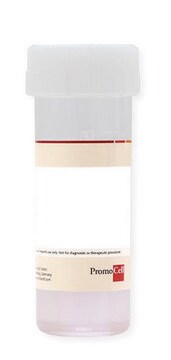Key Documents
T4049
Trypsin-EDTA solution
0.25%, sterile-filtered, BioReagent, suitable for cell culture, 2.5 g porcine trypsin and 0.2 g EDTA, 4Na per liter of Hanks′ Balanced Salt Solution with phenol red
Synonim(y):
Cocoonase, Tryptar, Tryptase
About This Item
Polecane produkty
pochodzenie biologiczne
Porcine
Poziom jakości
sterylność
sterile-filtered
linia produktu
BioReagent
Postać
solution
masa cząsteczkowa
23.4 kDa
stężenie
0.25%
metody
cell culture | mammalian: suitable
single cell analysis: suitable
zanieczyszczenia
Porcine parvovirus, none detected (9 CFR)
pH
7.0-7.6
Warunki transportu
dry ice
temp. przechowywania
−20°C
Szukasz podobnych produktów? Odwiedź Przewodnik dotyczący porównywania produktów
Opis ogólny
Zastosowanie
- in detaching HT29 human colorectal cancer cells cultured in RPMI 1640 which was supplemented with 10 % fetal calf serum, during relative cell frequency determination of high concentration samples.
- to trypsinize the transient transfected human embryonic kidney tcA-201 cell line.
- to enzymatically release mouse fibroblasts cells (cell line L929) adhered to the scaffold, during cell culturing to assess the influence of several modified treatments of Poly(L/D)lactide 96/4 non-woven scaffolds and fibres.
- to dissociate cells from the culture dish for flow cytometry analysis.
Działania biochem./fizjol.
Serine protease inhibitors, including DFP, TLCK, APMSF, AEBSEF, and aprotinin, amongst others, will inhibit Trypsin.
Komponenty
Przestroga
Uwaga dotycząca przygotowania
Nie możesz znaleźć właściwego produktu?
Wypróbuj nasz Narzędzie selektora produktów.
polecane
produkt powiązany
Kod klasy składowania
12 - Non Combustible Liquids
Klasa zagrożenia wodnego (WGK)
WGK 1
Temperatura zapłonu (°F)
Not applicable
Temperatura zapłonu (°C)
Not applicable
Certyfikaty analizy (CoA)
Poszukaj Certyfikaty analizy (CoA), wpisując numer partii/serii produktów. Numery serii i partii można znaleźć na etykiecie produktu po słowach „seria” lub „partia”.
Masz już ten produkt?
Dokumenty związane z niedawno zakupionymi produktami zostały zamieszczone w Bibliotece dokumentów.
Klienci oglądali również te produkty
Produkty
Serum-free defined cancer stem cell media used to grow and expand cancer cells in 3D tumorsphere aggregates.
Protokoły
Trypsin may be used to remove adherent cells from a culture surface. Cells are most commonly removed from the culture substrate by treatment with trypsin or trypsin/EDTA solutions.
Trypsin is frequently used in cell dissociation from adherent surfaces. We offer a wide variety of trypsin solutions to meet your specific cell line requirements, as well as protocols, troubleshooting ideas, and more.
Trypsyna jest powszechnie stosowana do oddzielania przylegających komórek od powierzchni. Dostępna jest szeroka gama roztworów trypsyny, aby spełnić specyficzne wymagania linii komórkowej.
Nasz zespół naukowców ma doświadczenie we wszystkich obszarach badań, w tym w naukach przyrodniczych, materiałoznawstwie, syntezie chemicznej, chromatografii, analityce i wielu innych dziedzinach.
Skontaktuj się z zespołem ds. pomocy technicznej






